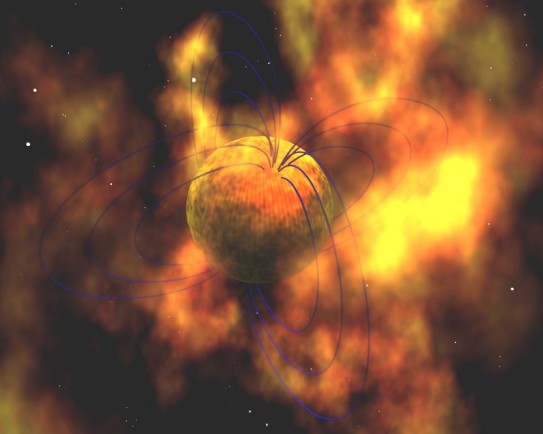
|
Explanation: What do you call a neutron star with a super-strong magnetic field? You guessed it ... a Magnetar. Imagine a star with more mass than the sun, the density of a neutron, and a magnetic field about a thousand trillion (a one followed by 15 zeroes) times stronger than Earth's. It sounds exotic and theoretical, but strong evidence for the existence of magnetars has recently been announced based on data from orbiting X-ray and Gamma-ray observatories. Neutron stars are formed in the violent crucibles of stellar explosions. Some become pulsars with relatively weak magnetic fields, spinning and emitting pulses of electromagnetic radiation as their rotation slows. However, astronomers now believe that some become magnetars, with magnetic fields so intense that the solid neutron star crust buckles and shifts under its influence. The resulting star quakes could repeatedly generate brief flashes of hard X-rays and soft gamma-rays giving rise to the rare but mysterious "soft gamma repeaters" (not to be confused with " gamma-ray bursters"!). This still frame from an animation illustrating a spinning, flashing magnetar emphasizes the looping magnetic field lines embedded in the X-ray hot neutron star surface.
|
January February March April May June July August September October November December |
| ||||||||||||||||||||||||||||||||||||||||||||||||
NASA Web Site Statements, Warnings, and Disclaimers
NASA Official: Jay Norris. Specific rights apply.
A service of: LHEA at NASA / GSFC
& Michigan Tech. U.
Based on Astronomy Picture
Of the Day
Publications with keywords: magnetar - soft gamma repeater - neutron star
Publications with words: magnetar - soft gamma repeater - neutron star
See also:
- APOD: 2025 September 3 Á Cir X1: Jets in the Africa Nebula
- GW200115: Simulation of a Black Hole Merging with a Neutron Star
- A Hotspot Map of Neutron Star J0030s Surface
- Unusual Signal Suggests Neutron Star Destroyed by Black Hole
- The Lonely Neutron Star in Supernova E0102 72.3
- NGC 4993: The Galactic Home of an Historic Explosion
- GW170817: A Spectacular Multiradiation Merger Event Detected
